 Research Article
Research Article
Thermo-Mechanical Properties and Applications of Glass Fiber Reinforced Polymer Composites
Mahfuza Farzana, Md Marjanul Haque, SM Sonali, MZI Mollah, Mohammad A Amin, Samiul A Khan, Farjana Islam and Ruhul A Khan*
Polymer Composite Laboratory, Institute of Radiation and Polymer Technology, Atomic Energy Research Establishment, Savar, Dhaka, Bangladesh
Ruhul A Khan, Polymer Composite Laboratory, Institute of Radiation and Polymer Technology, Atomic Energy Research Establishment, Savar, Dhaka, Bangladesh.
Received Date:October 09, 2023; Published Date: October 25, 2023
Abstract
Glass fibers have a wide application in various industries due to their great features such as high strength, flexibility, stiffness, and resistance to chemical damage. This fiber can be found in various forms, each of which represents its own set of attributes to be utilized. Glass fibers are largely used in the form a composite. Glass fiber reinforced polymer (GFRP) composites have been produced using various production techniques and are widely employed in a variety of applications. Because of their remarkable mechanical qualities, GFRP composite have received increased attention in recent years. The characteristics of GFRP composites can be greatly enhanced by increasing the volume of glass fiber content and using a different production process. This study deals with the analysis of different types of glass fiber, their properties, glass fiber reinforced composite and manufacturing processes.
Keywords: Glass fiber; Types; Mechanical properties; Polymer composites; Preparation methods
Introduction
The ancient Phoenicians and Egyptians were two glassmaking civilizations, and both used glass to produce fiberglass. Following that, numerous civilizations gained access to glass fiber technology and employed it for decorative elements, unknowing of its potential. Composite has been used for a variety of reasons since 1713, including insulating material, fiberglass clothing, airplane components, composite boats, and many others. A glass dress made for Broadway actress Georgia Cayvan and displayed at the World’s Columbian Exposition in Chicago in 1893 was made from bundles of spun glass fiber bound together with silk. The practice of spinning glass yarns to manufacture fabrics, on the other hand, is quite old [1].
Glass is a non-metallic fiber in nature that is frequently used in industry today. Glass fibers are made from silica, primarily sand, limestone, stone ash, and borax. It is a material composed of incredibly fine glass fibers. The high-strength glass fiber gives higher strength in lower density with excellent stability, durability, incombustibility, transparency, resistance to corrosion, excellent thermal, acoustic insulation, and specific electrical qualities in an impressively lightweight performance. Despite its strength properties are slightly lower than those of carbon fiber, the material is often less fragile, and the raw materials are significantly cheaper. When compared to metals, the bulk strength and weight qualities of fiberglass are also quite beneficial, and they can be easily manufactured utilizing moulding procedures. There are two types of glass fiber manufacturing processes: continuous filament and staple fiber. There are four types of forms of glass fiber: chopped strand, direct draw roving, woven mat, and chopped strand mat [2]. Figure 1 shows different forms of glass fiber.
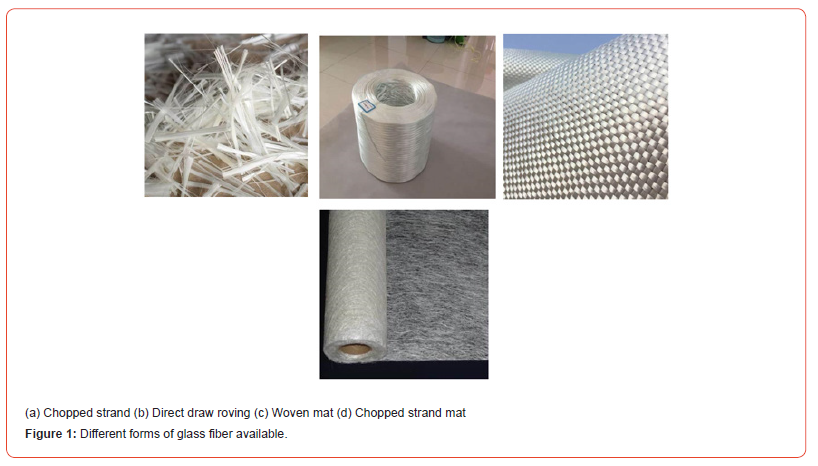
The most popular type of composite material is glass fiberreinforced polymer (GFRP) composite. Composites are formed by combining fiber material and matrix material. Hand layup, hot press, silicone rubber moulding, compression moulding, H-type press, and other production techniques were used to produce the GFRP composites. Organic, polyester, thermostable, vinylester, phenolic, and epoxy resins were used in the matrix. To improve the mechanical and tribological properties of the composites, various glass fiber reinforcements such as long longitudinal, woven mat, chopped fiber, and chopped mat have been generated [3]. Furthermore, the implementation of hard nanofillers favored the improvement of GFRP impact strength over tensile and flexural strengths. A 2 wt% incorporation of ZnO-TiO2 nanofillers was shown to be optimal for improving various strength values of the produced composites [4]. The interlaminar shear strength of composites and the thermal characteristics of the epoxy matrix deteriorated as the irradiation dose increased [5].
GFRP has been utilized successfully for several decades, in a variety of applications such as the maritime industry, plumbing industry, aircraft business, building, sports, consumer products, land transportation, clothes, and so on. Because of its effective resistance to the environment and damage for impact loading, high specific strength and stiffness, and lightweight, polymeric and laminated GFRP has a wide range of industrial applications like in marine industry and piping industries. However, the expensive cost of polymers limited their adoption in commercial applications [3, 6]. Furthermore, with the help of KOH, activated carboncoated glass fiber fabric was successfully used in wastewater treatment to uptake Cr (VI). This technology allowed for the longterm entrapment of harmful chromium ions in a glass matrix to generate color glass while removing Cr(VI) from wastewater [7]. The usage of an E-glass fiber-reinforced polymer composite in hostile conditions, such as effluent treatment plants, is possible. The morphological, structural, and mechanical properties, as well as fracture characterization, remained constant over an 8-month aging period in effluent treatment plants, demonstrating the potential of glass fiber composites [8].
In this paper, a review of glass fiber and manufacturing technologies is studied. The paper emphasizes the type of glass fiber, its physical and mechanical properties, different manufacturing process and the application of glass fiber as a composite.
Classification and Physical Properties of Glass Fiber
Glass is made out of quartz sand, soda, sodium sulphate, potash, feldspar, and a variety of refining and dying chemicals. The features, and thus the classification of the glass fibers to be produced, are dictated by the raw material combination and proportions. Classification of glass fiber, their physical properties and chemical composition are given below [2, 3, 6].
A-glass
It’s soda-lime glass, similar to window glass. This glass offers increased durability, strength, and electrical resistance. In A-glass fiber, 67.5% of SiO2, 3.5% of AI2O3, 1.5% of B2O3, 6.5% of CaO, 4.5% of MgO, 13.5% of Na2O and 3% of K2O are presented.
C-glass:
This type of glass is more resistant to chemical corrosion. This glass has 64.6% of SiO2, 4.1% of AI2O3, 5% of B2O3, 13.4% of CaO, 3.3% of MgO, 9.6% of Na2O and 0.5% of K2O as chemical composition.
D-glass:
D-glass is an essential form of glass fiber because it includes a lot of Boron trioxide. This glass has a low dielectric constant and shows resistant to heat and thermal shock. 74% of SiO2, 22.5% of B2O3, 1.5% of Na2O and 2% of K2O are presented in this glass.
E-glass:
E-glass is a type of calcium aluminosilicate glass. This glass incorporates the properties of C-glass with greater strength and electrical resistance. In E-glass fiber, 55.0% of SiO2, 14.0% of AI2O3, 0.2% of TiO2, 7.0% of B2O3, 22.0% of CaO, 1.0% of MgO, 0.5% of Na2O and 0.3% of K2O are presented.
AE-glass:
This glass is a type of Alkali resistant glass.
ECR-glass:
It shows higher strength in mechanics, an excellent waterproofing ratio, and resistance to electrical acidic and alkali corrosion. It outperforms E-Type glass fiber in terms of characteristics. The most significant benefit is a more environmentally friendly glass fiber.
AR-glass:
Alkali Resistant (AR) Glass Fibers are specifically intended to concrete construction. They are made up of alkaline zirconium silicates. They work well to keep concrete from cracking thus concrete gains strength and flexibility. This glass is suited for applications that require strong acidity and mechanical strength.
R-glass:
R-glass shows better tensile and acidic strength, resistance to acid corrosion, and wetting properties than E-glass. This glass has 60.0% of SiO2, 24.0% of AI2O3, 9.0% of CaO, 6.0% of MgO, 0.5% of Na2O and 0.1% of K2O as chemical composition.
S-glass:
S-glass shows better tensile strength. 65.0% of SiO2, 25.0% of B2O3, and 10.0% of MgO are presented in this glass.
S2-glass:
This glass has higher strength, modulus and stability as physical properties.
Mechanical and Thermal Properties of Glass Fiber
Glass fiber offers excellent mechanical and thermal qualities, as well as a high surface-to-volume ratio. Because of the greater surface area, they are far more vulnerable to chemical attack. Glass fiber blocks provide good thermal insulation by trapping air within them. The mechanical and thermal properties of different types of glass fiber are shown in Table 1.
Table 1:Mechanical and Thermal Properties of Different Glass Fibers.
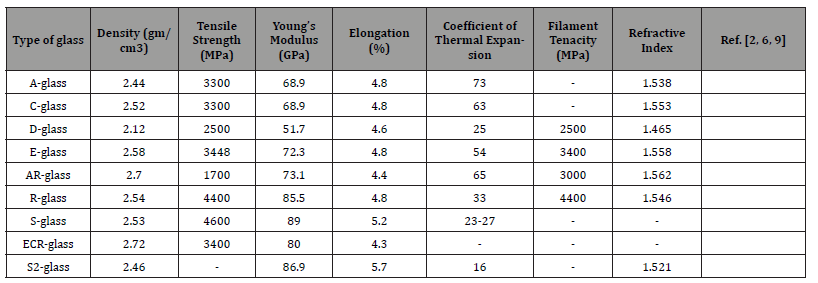
Manufacturing Process of Glass Fiber
The concept of producing glass fiber and yarn dates back centuries. The viscosity of glasses is crucial for manufacturing performance. The viscosity should be reasonably low during drawing. If viscosity is exceeded, the fiber might break at the time of drawing and If it is too low, the glass might begin to form droplets instead of pulling out into fiber. Glass is normally evaluated for strength after it has been manufactured. The thinner the fiber, the stronger it is. The more the surface scratches, the lower the consequent tenacity. Glass fibers are manufactured by two processes described below [2, 6].
Continuous Filament Process
This process was first developed in 1930 for high-temperature electrical applications. The molten glass is passed through spinnerets with hundreds of tiny openings in this procedure (Figure 2). These strands of several filaments are conveyed to a winder that rotates at a rate of more than 2 miles per hour. This procedure pushes the fibers out in parallel filaments the size of the openings. Sizing or a binder is used at the time of twisting and winding that prevents possible yarn breakage. Then filaments get twisted and plied to create yarns. These yarns are employed to make products like curtains and drapes.
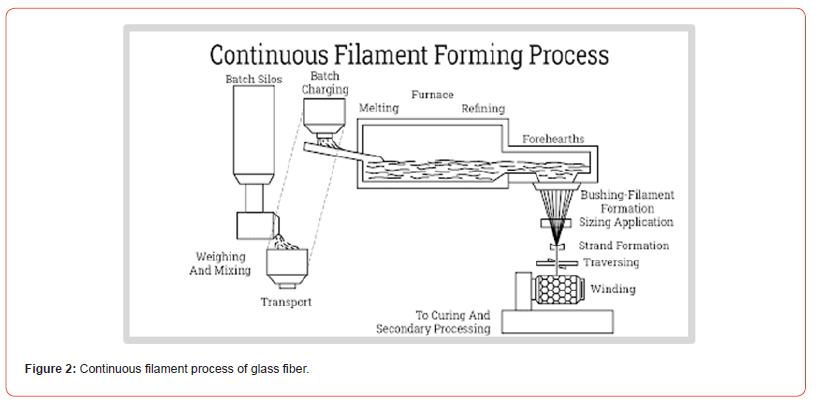
Staple Fiber Process
The staple fiber technique produces fibers with long-staple characteristics. At first, molten glass flows to bushing through tiny holes. Here these thin streams of molten glass are shaken by compressed air jets thus making them into fine fibers. These fibers range in length from 8 to 15 inches. Then the fibers go into the revolving drum and aid by lubricant spray and drying flame and those fibers turn into a thin web. These web-like threads are taken from the drum to a sliver. From this silver, then create the yarn using procedures similar to those used to make cotton or wool yarns. These yarns get used in fabrics for industrial applications that require insulation.
Glass Fiber Reinforced Polymer Composite
Glass fiber reinforced composites (GFRP) started out being used in structural aircraft parts in 1942. It has desirable features such as low density, high strength, ease of processing, better electrical properties, and moisture, heat, and chemical resistance. Physical, mechanical, electrical, thermal, acoustical, optical, and radiation properties are used to compare the benefits of high-strength glass fiber composites. The strength of glass fiber composites is greater than that of most other materials [6]. Table 2 shows the mechanical properties of glass fiber-reinforced polymeric composite and the preparation method of GFRP is shown in Figure 3.
Natural fibers have been used as substitute reinforcement in polymer composites in recent years because of their benefits over traditional glass and carbon fibers. Flax, hemp, jute, sisal, kenaf, coir, kapok, banana, and other natural fibers are among them. Natural fibers outperform glass fibers and others in terms of flexibility, stiffness, low cost, low density, tensile properties, non-irritation to the skin, reduced energy consumption, lower health risk, renewability, recyclability, and biodegradability [10]. Despite their appeal, natural fiber-reinforced polymer composites have inferior mechanical characteristics and moisture resistance when compared to synthetic fiber-reinforced composites like GFRP. Natural fiberreinforced composites can be benefited from the addition of glass fiber or carbon fiber in terms of improving stiffness, strength, and moisture resistance. As a result, good material design could provide a balance of performance and cost. Although having good thermal and mechanical properties, a suitable disposal method seems to be harder for GFRP composites. Because of several environmental issues, GFRP composite’s disposal and recycling have received substantial consideration [11, 12].
Table 2:Different Properties of Glass Fibers reinforced composites.
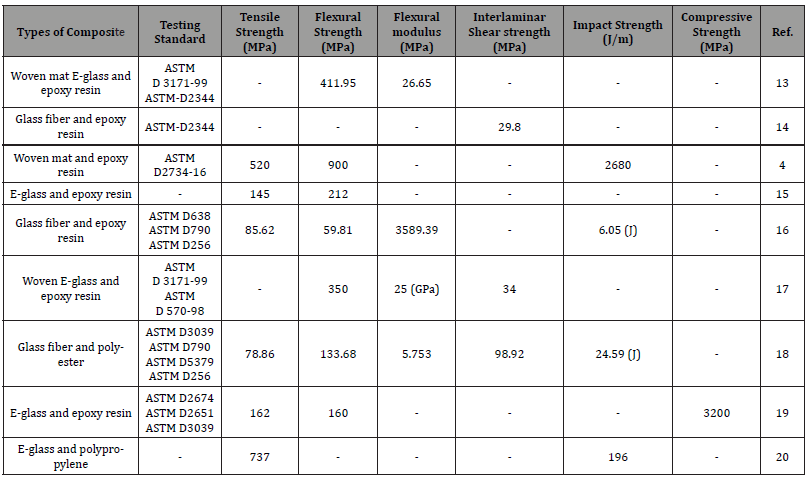
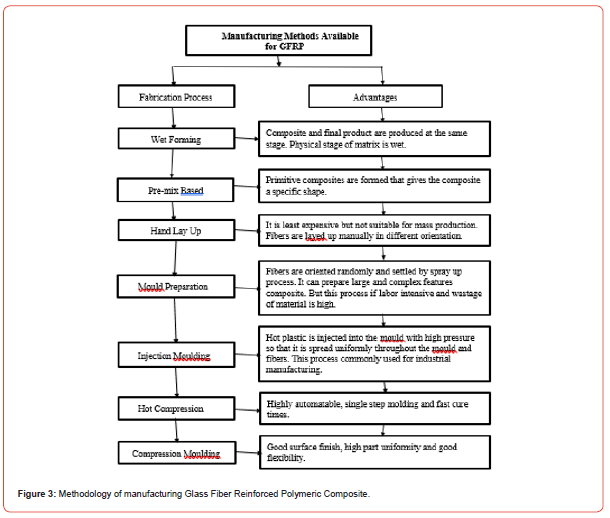
Application [2, 3, 6, 11]
In medical
Glass fiber composites are put to use in medicine for a variety of purposes due to their low porosity, non-staining finish, and durability. Knitted fiberglass fabrics are commonly used in orthopedic and dental casts, ranging from instrument enclosures to X-ray beds (Figure 4).

In automobile
Different automobile parts such as body panels, seat cover plates, door panels, tire reinforcement etc. are made of GFRP (Figure 4). In comparison to steel-reinforced tires, glass-reinforced tires offer a smoother ride, more resistance against harm, improved stability, and cheaper reinforcing cost. More than 154 potential GFRP vehicle applications existed to assist automakers in meeting future energy consumption requirements. Railroad fishplates are also successfully installed by GFRP (Figure 5).
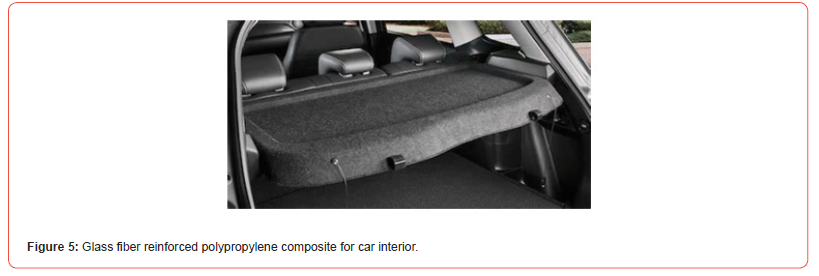
In aviation
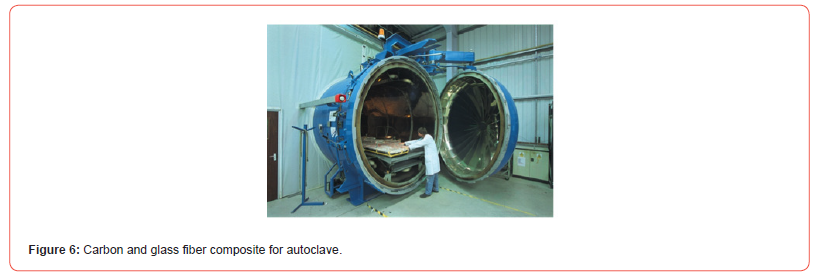
Because of its lightweight, capacity to endure severe loads, resistance to corrosion, low cost, and dimension stability, glass fiber is excellent for application in the aviation sector. Glass fiber can be used in storage bins, aircraft toilets, engine cowlings, luggage racks, antenna enclosures etc. S-glass, specifically, has low thermal conductivity and is stronger than E-glass. It’s commonly found in the making of aircraft components like flight deck armor, helicopter armor, seats, and floors (Figure 6).
In construction and home
Because of its consistency in dimension, excellent durability, lightweight, resistance to impact and corrosion, minimal flammability, and design adaptability, glass fiber is frequently utilized in construction and household applications. Roof sheets, bathroom stuff, windows, exhibit racks, book racks, and tea tables also are all made from this fiber composite. GFRP has been employed in pediments, cornices, paneling, insulation from the heat in refrigerators and stoves, roofing uses such as sealing and waterproofing, aesthetically pleasing coverings on the walls, partitions, furniture, gypsum boards and so on. Composites, for example, give an excellent capacity for loading with material weight in bridge building. This minimizes the need for heavy equipment to construct the bridge also reducing installation time (Figure 7).
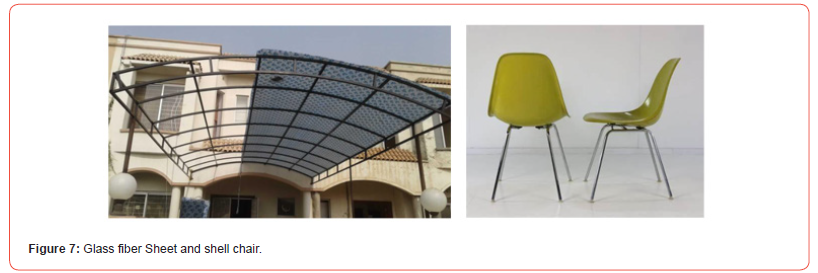
In electronics
GFRP has been widely utilized in the fabrication of circuit boards, Television, computer, mobile phones, electric motor covering, wires and cables etc. Glass fabrics have become popular in the industry due to their toughness, thermal and weather stability and higher dielectric strength. They’re also employed in distribution-pole hardware, switchgear, transformers, and telephones (Figure 8)

In the marine industry
Because GFRP is a lighter material than wood and metals, it is presently used in the construction of 70% of all boats. The key advantages of employing GFRP as an appropriate material for boat construction are higher strength, great durability, minimal upkeep, and corrosion resistance. Other applications for GFRP include small motorboats, water sports surf, ski boats, sailboats, fishing boats and rods, submersibles and so on (Figure 9).
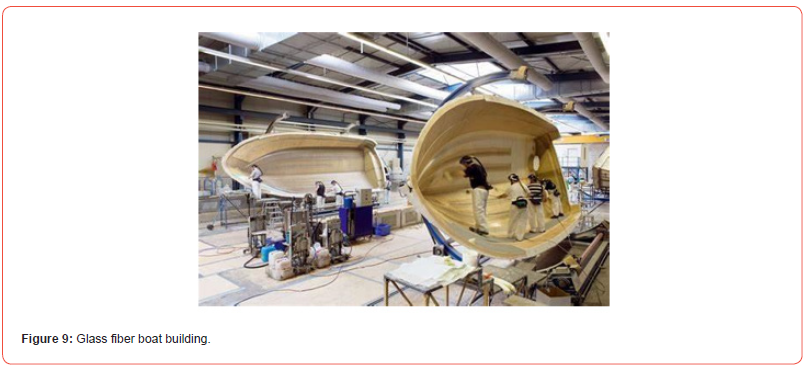
Conclusion
In this study, the types and properties of glass fiber, their manufacturing process, mechanical properties and different preparation methods of glass fiber composite have been studied. For GFRP composites with varying environmental conditions, various preparation processes were applied. It is concluded that when used for various purposes, glass fiber with epoxy resin provides higher mechanical qualities. These high-quality composites are typically employed in aerospace and automotive applications. Because glass fiber is less expensive than carbon fiber and metals, it is increasingly being used as a reinforcing agent in the composite sector. With new technological advancements in fiberglass and resins, their composites will always be able to meet the demands of every engineering discipline. Given the widespread use of GFRP, an increase in production must be considered.
Acknowledgment
The research work was supported by the Annual Development Project (ADP) of Bangladesh Government. The title of the project is: “Strengthening of existing gamma source of Bangladesh Atomic Energy Commission”. Special thanks to The Ministry of Science and Technology and The Ministry of Planning, Government of the People’s Republic of Bangladesh.
Conflict of Interest
All authors state that there is no conflict of interest.
References
- S P Mishra (2000) A Text Book of Fibre Science and Technology. New Age International.
- Mazharul Islam Kiron (2012) Glass Fiber: Types, Properties, Manufacturing Process and Uses.
- TP Sathishkumar, S Satheeshkumar, J Naveen (2014) Glass Fiber-reinforced polymer composites-a review. Journal of Reinforced Plastics and Composites 33(13): 1258-1275.
- Sridhar Thipperudrappa, Anupama Hiremath, Bharath Kurki Nagarag (2021) Synergistic effect of ZnO and TiO2 nanoparticles on the thermal stability and mechanical properties of glass fiber-reinforced LY556 epoxy composites. Polymer Composites 42(9): 4831-4844.
- ZX Wu, JW Li, CJ Huang, RJ Huang, LF Li, et al. (2013) Effect of gamma irradiation on the mechanical behavior, thermal properties and structure of epoxy/glass-fiber composite. Journal of Nuclear Materials 441(1-3): 67-72.
- Mazharul Islam Kiron (2012) Glass Fiber Composites: Properties. Manufacturing and Applications.
- Meiling Huang, Shivani Bhardwaj Mishra, Shiquan Liu (2017) Waste glass fiber fabric as a support for facile synthesis of microporous carbon to adsorb Cr(VI) from waste water. ACS sustainable chemistry and Engineering 5(9): 8127-8136.
- Yldeney Silva Domingos, Renata Carla Tavares dos Santos Felipe, Raimundo Nonato Barbosa Felipe, Glauber Jose Turolla Fernandes (2019) Evaluation of the environmental aging of the glass fiber-reinforced polymer composite when in contact with the effluent of a treatment plant. Journal of Composite Materials 54(11): 1385-1402.
- Priyadarsini Morampudi, Kiran Kumar Namala, Yeshwanth Kumar Gajjela, Majjiga Berath, Ganaparthy Prudhvi, et al. (2021) Review on glass fiber reinforced polymer composites. Materials Today 43(1): 314-319.
- Kamrun N Keya, Nasrin A Kona, Farjana A Koly, Kazi Madina Maraz, Md Naimul Islam, et al. (2019) Natural fiber reinforced polymer composites: history, types, advantages, and applications. Materials Engineering 1(2): 69-87.
- Sanjay M R, Arpitha G R and B Yogesha (2015) Study on Mechanical Properties of Natural-Glass Fiber Reinforced Polymer Hybrid Composites: A Review. Materials Today 2(4-5): 2959-2967.
- F G Torres, ML Cubillas (2005) Study of the interfacial properties of natural fiber reinforced polyethylene. Polymer Testing 24(6): 694-698.
- Ramesh Kumar Nayak, Dinesh Rathore, Bharat Chandra Routara, Bankim Chandra Ray (2016) Effect of nano AL2O3 fillers and cross head velocity on interlaminar shear strength of glass fiber reinforced polymer composite. International Journal of Plastics Technology 20: 334-344.
- Chen-Yang Dang, Bo-Lin Tang, Xiao-Ling zeng, Jiao Xu, Minh-Jia Feng, et al. (2019) Improved interlaminar shear strength of glass fiber/epoxy composites by graphene oxide modified short glass fiber. Materials Research Express 6(8): 085324.
- Tahar Marizzgui, Bachir gaoui, Tamer A Sabaey, V R Arun Prakash (2020) Electromagnetic shielding behavior of epoxy multi-hybrid composites comprises of E-glass fiber, Ag nanoparticle, and Ni nanosheet: A novel approach. Polymer Composites 42(5): 2484-2491.
- RA Braga, PAA Magalhaes Jr (2015) Analysis of the mechanical and the thermal properties of jute and glass fiber as reinforcement epoxy hybrid composites. Materials Science and Engineering 56(1): 269-273.
- Ramesh Kumar Nayak, Kishore Kumar Mahato, Bankim Chandra Ray (2016) Water absorption behavior, mechanical and thermal properties of nano TiO2 enhanced glass fiber reinforced polymer composites. Composites Part A: Applied Science and Manufacturing 90: 736-747.
- D Chandramohan, B Murali, P Vasantha-Srinivasan, S Dinesh Kumar (2019) Mechanical, Moisture Absorption, and Abrasion Resistance Properties of Bamboo-Jute-Glass Fiber Composites. Journal of Bio-and-Tribo-Corrosion 5(3): 1-8.
- G B Veeresh Kumar, R Pramod (2017) Investigation of Mechanical Properties of Aluminium Reinforced Glass Fiber Polymer Composite. AIP Conference Proceedings 1859: 1-7.
- Meysam Nouri Niyaraki, Faramarz Ashenai Ghasemi, Ismail Ghasemi, Sajjad Daneshpayeh (2021) Predicting of Impact Strength and Elastic modulus of Polypropylene/EPDM/Graphene/Glass Fiber Nanocomposites by Response Surface Methodology. Tehnicki glasnik 15(2): 169-177.
-
Mahfuza Farzana, Md Marjanul Haque, SM Sonali, MZI Mollah, Mohammad A Amin, Samiul A Khan, Farjana Islam and Ruhul A Khan*. Thermo-Mechanical Properties and Applications of Glass Fiber Reinforced Polymer Composites. Mod Concept Material Sci. 5(3): 2023. MCMS. MS.ID.000614.
-
Glass fiber, Types, Mechanical properties, Polymer composites, Preparation methods, Fiberglass clothing, Composite boats, Airplane components, Polyester, Thermostable, Phenolic, Organic
-

This work is licensed under a Creative Commons Attribution-NonCommercial 4.0 International License.






